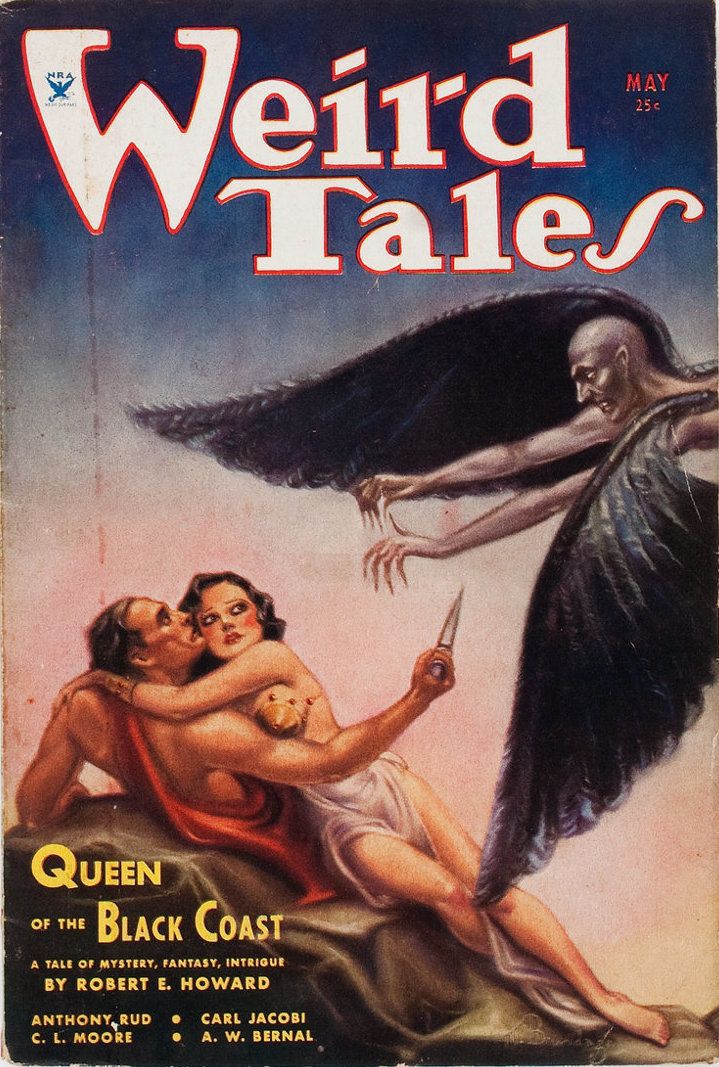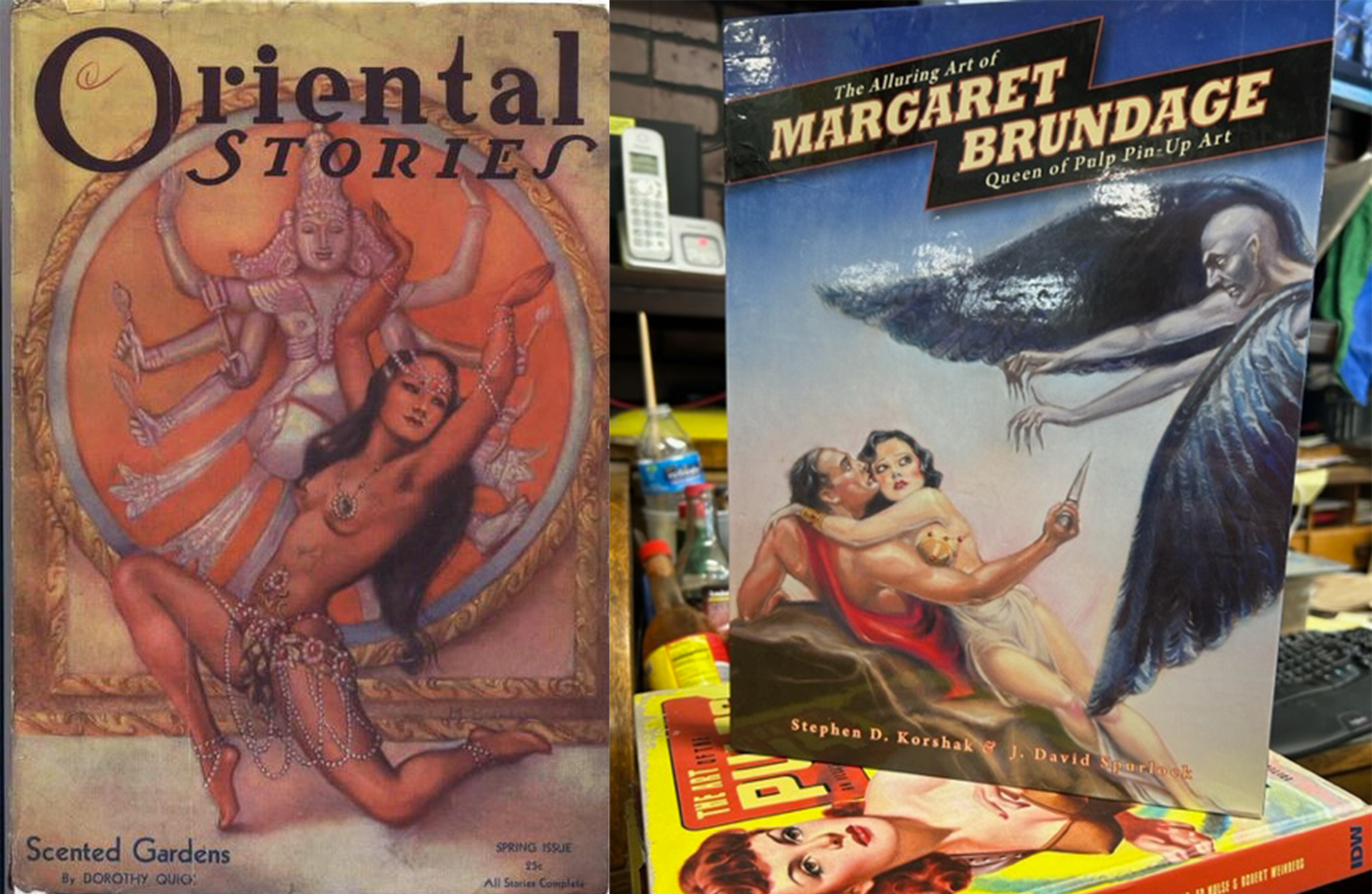Cover of the pulp magazine- Oriental Stories (Spring 1932, vol. 2, no. 2) featuring Scented Gardens- by Dorothy Quick. Cover art by Margaret Brundage.
Although Mary Shelley’s Frankenstein; or the Modern Prometheus (1818) is generally credited as the beginning of science fiction, in the early years of science fiction, there were very few women writers published. Margaret Cavendish (The Blazing Worlds, 1666) was another exception, particularly outside of the gothic novels. There were a limited number of women authors in the science fiction/fantasy/horror pulps from the 1920s until the end the 1950s. Some of the more notable members of this limited group include Clara Winger, Andre Norton, C. L. Moore, James Tiptree, Leigh Brackett, Miriam Allen deFord, and Bertude Barrows Gennett. Now, women writers are common, and their absence early in science fiction history is regularly discussed in the science fiction literature, itself.
The illustrators of science fiction, fantasy, and horror were also almost entirely men in the early years. With the exception of the husband-wife team Leon and Diane Dillon, there were very few women illustrators of science fiction, fantasy, and horror prior to the 1960s. Women illustrators have become more common since the 1970s (see Julie Bell, Rowena Morrill, and Olivia De Berardinis).
Most people are probably unfamiliar with Margaret Brundage who was ‘Queen of the Pulps’ and the first woman science fiction, fantasy, and horror illustrator, starting way back in the 1930s. Unless you go to the original Weird Tales or their associated magazines, which are very scarce, you will not see Margaret Brundage’s work. If you are purchasing early pulps, you should expect that her covers will raise the cost of the pulp by about 300%. A new book, The Alluring Art of Margaret Brundage, Queen of Pulp Pin-up Art by Stephen Korshak and J. David Spurlock, was published in 2013. It is a truly seminal work as well as a relatively expensive book. You can see Margaret’s influence in many of the current science fiction illustrators. Her greatest exposure these days is in books showing Weird Tales or other early pulp covers.

Margaret Brundage was born Margaret Hedda Johnson in 1900 in Chicago, Illinois. She was high school classmates with Walt Disney, then she attended the Art institute of Chicago and the Chicago Academy of Fine Arts. Margaret initially worked in the fashion illustration industry (she was apparently a very avant-garde lady). She also worked at the Dill Pickle Club and a bohemian speakeasy, where it is believed she met her husband Myron “Slim” Brundage. Slim Brundage was a writer, radical, and labor union activist who was part of the bohemian society at the Dill Pickle Club, which was associated with the Industrial Workers of the World, aka the ‘Wobblies’. They got married and had a son, but then were divorced in 1939.
Margaret became involved with the Chicago South Side Black Community and helped start the South Side Community Art Center funded under the WPA. Margaret actually served as president of the center for a few years. She was friends with Chicago Black community leaders like Dr. Margaret Burroughs and the far left/bohemian groups in Chicago during the 1940s, 1950s, and 1960s. Off and on throughout this period, she and Slim were together after the divorce, despite his remarriage.
Based on Robert Weinberg’s interview with her, which is documented in Korshack's book, in 1932 she approached the publisher of Weird Tales, Farnsworth Wright, for work as an illustrator. This she did apparently at random and without any background in science fiction, fantasy, or horror illustration. Based on her portfolio, Farnsworth hired her to do covers for Oriental Stories and Weird Tales. She received $90 per cover. Margaret worked in pastels and chaulk, which gives her work a unique look for its era. She typically drew from her imagination rather than from studio models. She would read the story to be illustrated and do several rough drafts, which were reviewed by the editors, and then she would prepare the final illustration.
Margaret’s covers were often considered to be risqué, but were never brought up on charges related to pornography. Her work, though outrageously sexy and mysterious in peril, had a unique sense of dignity. As often as possible, Margaret portrayed her women as admirable, heroic, or powerful. When there was bondage or subjugation, she frequently had women in charge. All of these touches were contributions outside of Farnsworth’s request to bring the works more in line with Margaret’s interests in equal rights for women and minorities.
Robert E. Howard and Seabury Quinn were fans of Margaret’s covers, while H. P. Lovecraft was her biggest critic. Margaret’s covers were controversial among the reader’s pages, too, but her illustrations seemed to have a positive impact on circulation.
Margaret has published scores of covers, mostly in the 1930s and 1940s, for Oriental Stories, Magic Carpet, Weird Tales, and Golden Fleece.
Her work inspires the artists of today, but she was the first woman to become a dominant force in science fiction illustration in a field almost totally dominated by men. From 1932 to 1938, Margaret was prolific on the covers of the Rural Corporation’s ‘unique/weird’ magazines. In 1938, Weird Tales was sold to William Delaney (the publisher of Short Stories) who moved the operation to New York City, and Framsworth Wright died shortly thereafter. Margaret was unwilling to move to New York City, and her pastel and chaulk art did not travel well, so she parted ways with the company. She continued as a freelance artist in the Chicago area, where she attended science fiction conventions and art shows for the rest of her life. Margaret died in 1976, having been an artist for her entire adult life.
It should be noted again that Margaret’s covers are often considered particularly risqué. The author of this article once planned a display at a local library to honor this pioneering science fiction illustrator, but as we started to finalize the plan in detail, it was determined that the local ‘city fathers’ of the 2000s would probably find it unacceptable.
This article is just a short summary of Margaret Brundage’s life and art, drawn from a variety of sources. To learn more, check out these references:
- Stephen D. Korshak & J. David Spurlock, The Alluring Art of Margaret Brundage: Queen of Pulp Pin-Up Art, Vanguard, 2013.
- Wikipedia: wikipedia.org/wiki/Margaret_Brundage, retrieved 10/14/2023.
- Roger Luckhurst, et al, The Astounding Illustrated History of Fantasy & Horror, Flame Tree Pub. 2018.
- Peter Nicholls, The Science Fiction Encyclopedia, Dolphin Books, 1979.
- The Weird Tales Collector, No. 1–6.
- Douglas Ellis, Ed Hulse, & Robert Weinberg, The Art of the Pulps, An Illustrated History, Elephant Books, Co. LTD, 2017.
- Tony Goodstone, The Pulps: Fifty Years of American Pop Culture, Bonanza, 1970.
Steven Woolfolk is the owner of Xenophile Bibliopole & Armorer, Chronopolis Xenophilebooks.com

